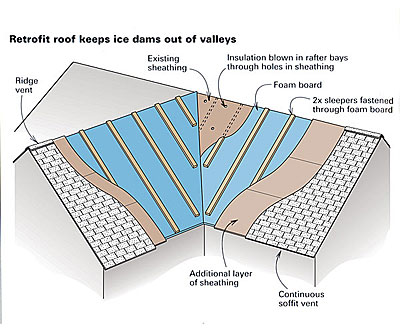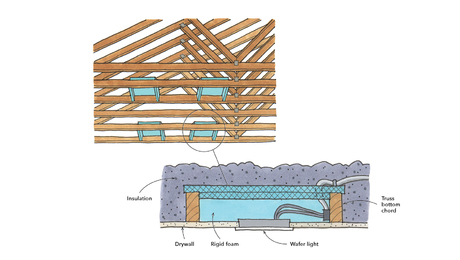Q:
The roof of my house has a valley with a living space directly below. The rafter bays were not insulated adequately when the house was built, and because the rafters in the valley terminate at the valley rafter, those rafter bays are completely sealed and cannot be ventilated. As a result, heat escapes from the living space, melting snow on the roof and creating an ice dam in the valley. I would like to avoid the costly, messy solution of ripping out the finished ceiling in the living space to reinsulate and refinish. I was thinking instead of laying 2x sleepers and sheathing on top of the existing roof to create a second roof. The space between the sheathing layers would provide airflow. Would this idea work?
Christopher R. Allen, Bedford, NH
A:
Paul Fisette, director of building-materials technology at the University of Massachusetts, Amherst, replies: Your valley roof over a finished ceiling is one of the most difficult design problems regarding ice-dam prevention. Your diagnosis is correct. The inadequate insulation coupled with the dead-end rafter bays between the valley jack rafters that lack ventilation causes snow to melt on the upper region of your roof (over the living space). The melted snow then refreezes at the cold eaves. The challenge is to keep the entire surface of the roof cold.
Your idea of stripping the existing ceiling is indeed an expensive, intensive approach and will work, but only up to a point. Combining thicker insulation with an air barrier would certainly reduce the heat lost from the house through the roof. However, remember that wood has an R-value of only 1 per in., so each 2×8 rafter has an R-value of about 8, which is less than half of an adjacent rafter cavity insulated with 6-in. fiberglass. The rafters conduct more heat from the living area directly to the underside of the roof sheathing in an area where there is still no ventilation, again causing snow to melt and ice dams to form in the valley. You can improve this situation somewhat by sheathing the underside of the rafters with rigid-foam insulation to create a thermal break. But it is perhaps the snow itself that poses the greatest threat in a valley location.
Snow tends to collect more deeply in valleys. Snow also has an R-value of about 1 per in. and acts as a blanket of insulation, holding heat in the house. So if the outside temperature is 20°F and there is 6 in. of snow on top of a roof with R-19 insulation, warmth from a 70°F living space can easily raise the surface temperature of the roof above freezing, again resulting in ice dams. And snow melt occurs even more easily directly over valley and jack rafters.
Your idea of creating a second roof over the existing roof sheathing seems like a better way to go. I strongly recommend that you fill the rafter bays with blown-in cellulose insulation while the sheathing is exposed and the bays are easily accessible. I would add a layer of 1-in. rigid-foam insulation with the seams taped right on top of the sheathing and lay the 2x sleepers on top of the foam, making sure that the sleepers don’t meet in the valley to cut off ventilation.
Just because you’ve made a ventilating airspace under the roof doesn’t mean that the air will follow the path you created. A baffled ridge vent combined with continuous soffit vent in the newly built eaves will ensure that air flows between the layers of sheathing. Finally, apply an adhesive-backed, self-healing rubberized membrane to redirect water that might get through the valley-flashing system.
Fine Homebuilding Recommended Products
Fine Homebuilding receives a commission for items purchased through links on this site, including Amazon Associates and other affiliate advertising programs.

Ladder Stand Off

Loctite Foamboard Adhesive

Flashing Boot


























